This post may contain affiliate links. Please read our disclosure policy.
Golden like a sunset, this Persian tahdig is irresistibly crispy and fluffy. Made with saffron, turmeric, and yogurt, this recipe packs lots of Middle Eastern flavors that are 100% irresistable.

The Best Crispy Persian Rice
With a pinch of saffron and turmeric, this easy Persian tahdig has all the delicate spice you’d expect from Middle Eastern rice. Once you flip it over and put it on the table, it’ll be the prettiest pot of rice you’ve ever made.
Don’t forget to add ghee, yogurt, and an egg yolk to the rice mixture, though. While they help make the rice extra crunchy, they also add a lovely richness. As it cooks, this Persian rice will develop the perfect balance of crispy and fluffy textures for an incredible bite.
Why You’ll Love this Tahdig Recipe
- Elegant. If you’re looking for a side dish that will wow your dinner guests, tahdig is it! This golden and crispy recipe recipe makes the kind of side you can usually only find at fancy restaurants.
- Flavorful. Every bite of this dish is bursting with flavor. Add that to the crisp crunch or the golden rice and you’ve got yourself one tasty mouthful.
- Flexible. You can serve tahdig with a wide variety of toppings and main dishes. I’ve shared some ideas below.
What Is Tahdig?
Tahdig is a Persian dish, meaning “bottom of the pot.” It refers to a layer of golden, crispy rice that develops at the bottom of the pot— which is the whole point of tahdig. Think of it as the slightly crunchy rice you get when you accidentally overcook it for a couple extra minutes. In Iran, it’s not a mistake, though. It’s a very intentional effort that has turned into a cooking method of its own. If it’s got a crispy rice bottom, it’s tahdig.
Traditionally made with Basmati or Jasmine rice, it can be as simple or as complex as you want. Some varieties include saffron, yogurt, turmeric, dried fruits and nuts, sliced potatoes, and even lavash bread.

Recipe Ingredients
With Basmati rice and a bit of yogurt, you’re all set to make great Persian tahdig. Here’s a quick look at what you’ll need. Be sure to check the recipe card at the bottom of the post for full ingredient amounts.
- Basmati rice: Jasmine rice and other long-grain white rice work too.
- Salt, Saffron Threads, Ground Turmeric
- Unsweetened plain yogurt
- Egg yolk
- Vegetable oil: Canola, corn, and olive oil work too.
- Ghee: Feel free to substitute it for unsalted butter.
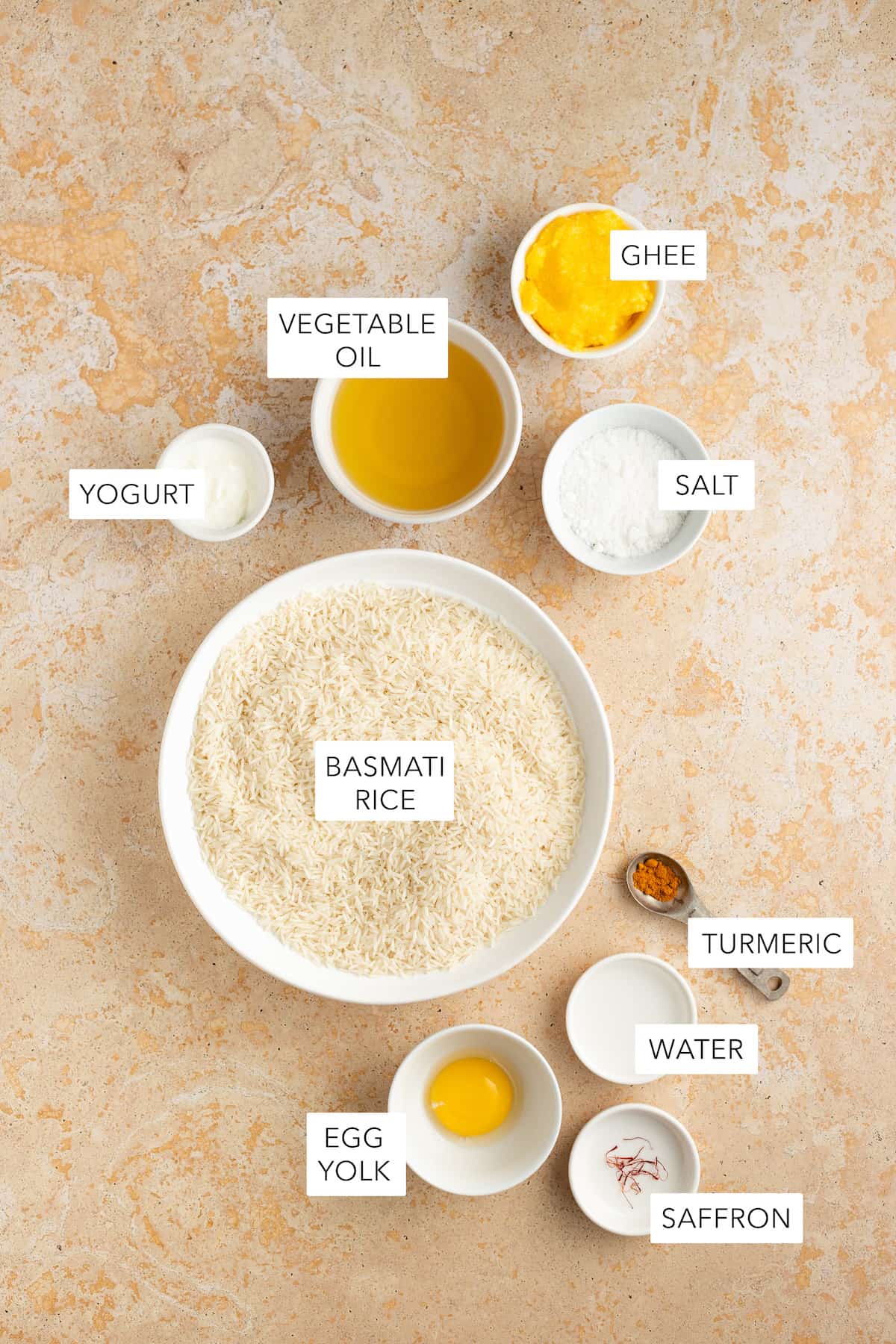
Variation Ideas
- Make it sweet. Substitute the salt for sugar, and the plain yogurt for sweetened yogurt to make a crispy rice dessert.
- Add potatoes. Use a mandolin to thinly cut 1 small potato into 1/4″ thick slices. Skip the saffron and yogurt rice mixture at the bottom of the pot and swap it for a thin layer of potatoes. Cook the rice as usual or until the potatoes are nice and crispy.
- Use lavash. Place raw lavash bread at the bottom of the pot instead of the yogurt mixture. It will cook and crispen, creating another yummy version of tahdig.
How to Make Tahdig Rice
Are you ready to make tahdig right in your kitchen? Here’s how to do it:
To Prepare the Rice
- Rinse the rice several times in a bowl until the water is clear.
- Soak the rinsed rice, with salt, in warm water for four hours, covered with a towel.
- Boil the soaked rice for 2.5 minutes until al dente, rinse with warm water, and set aside.
For the Saffron Mixture
- Bloom the saffron. Grind the saffron threads to make a fine powder. Place it in a small bowl and add 4 teaspoons of cold water. Stir well and let it rest for 10 minutes. Stir again and let it sit for 5 minutes.

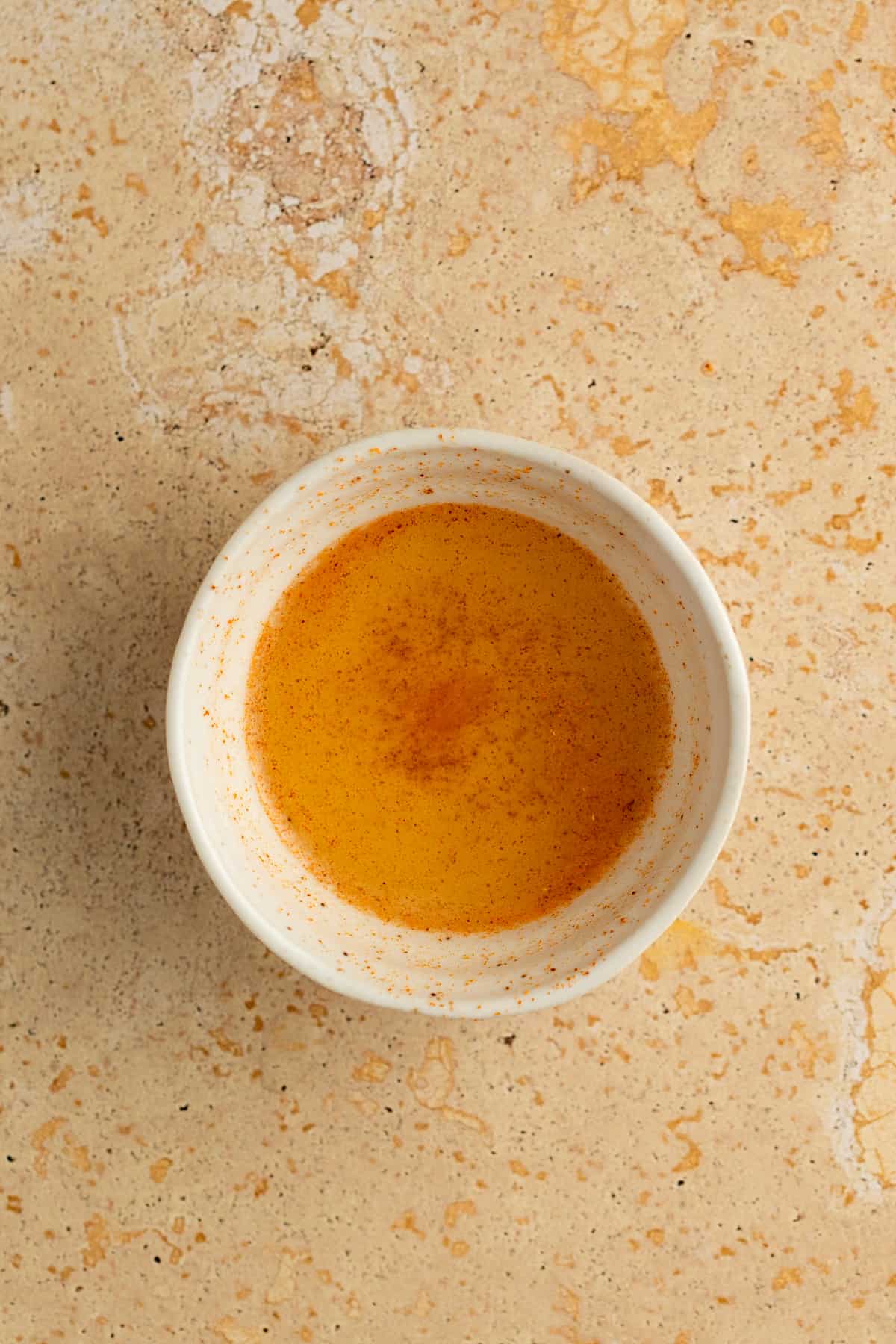
- Mix the yogurt. In a separate bowl, whisk the yogurt, ground turmeric, saffron mixture, and yolk until well combined. Add a quarter of the rice to the mixture. Use a wooden spoon to fold it in gently.
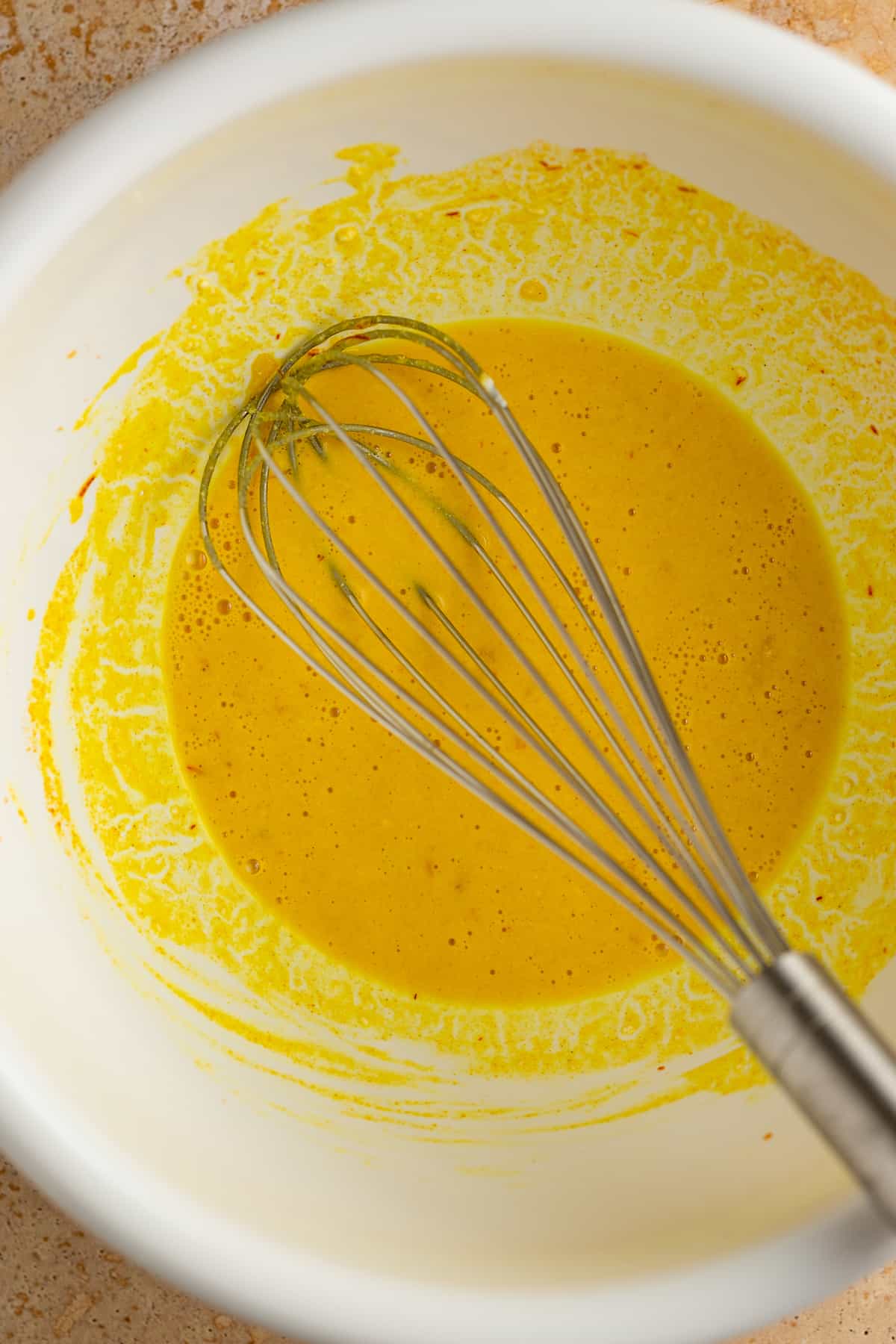

To Cook the Tahdig
- Prepare the crust. Add the oil to a medium-sized pot over medium heat. Add the yogurt-rice mixture and use a wooden spoon or silicone spatula to spread it out evenly across the bottom of the pot. Let it cook for 5 minutes. Add the remaining rice on top and spread it out evenly. Press it down gently but don’t pack it too tightly.
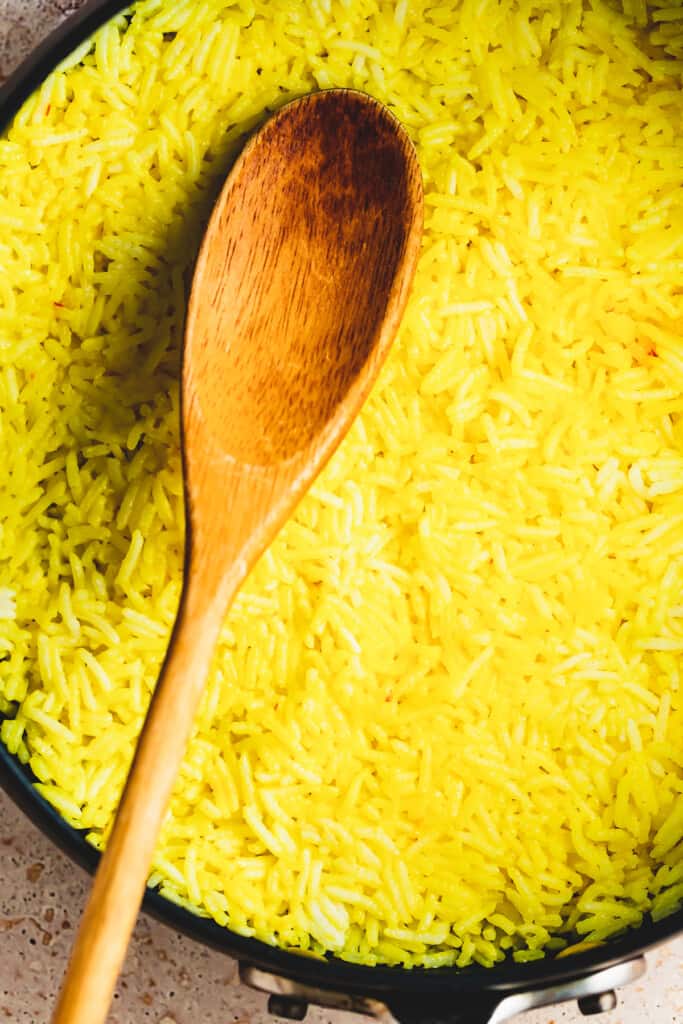
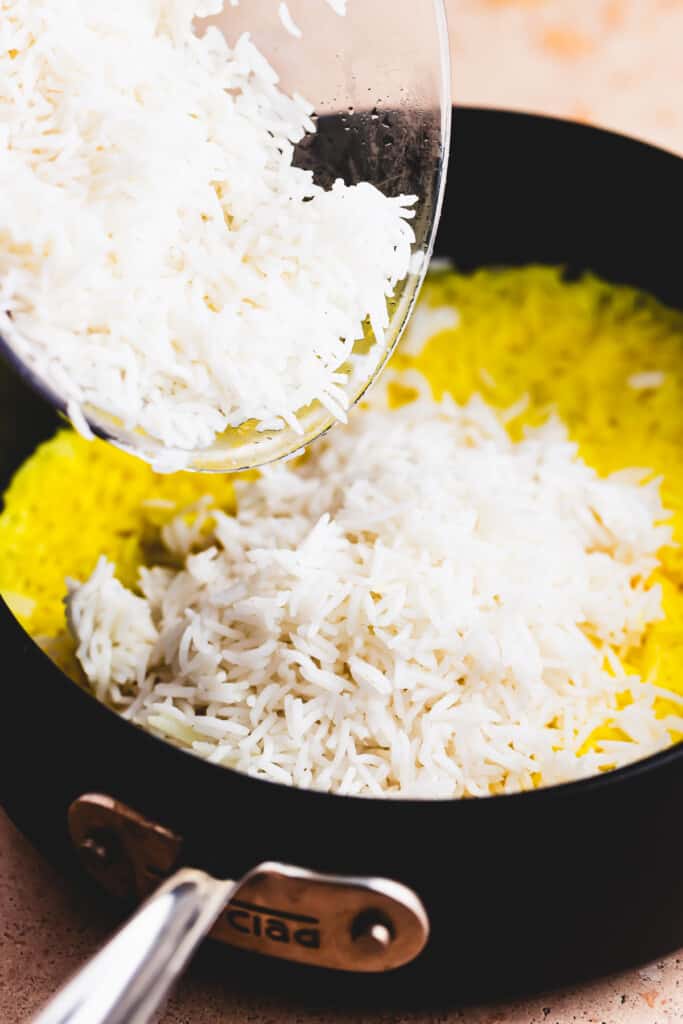
- Poke holes. Drizzle the ghee on top. Use the back of a spoon to poke holes in the rice, without touching the bottom of the pot but getting as close to it as possible. This is extremely important for a crispy crust because it allows the steam to rise.
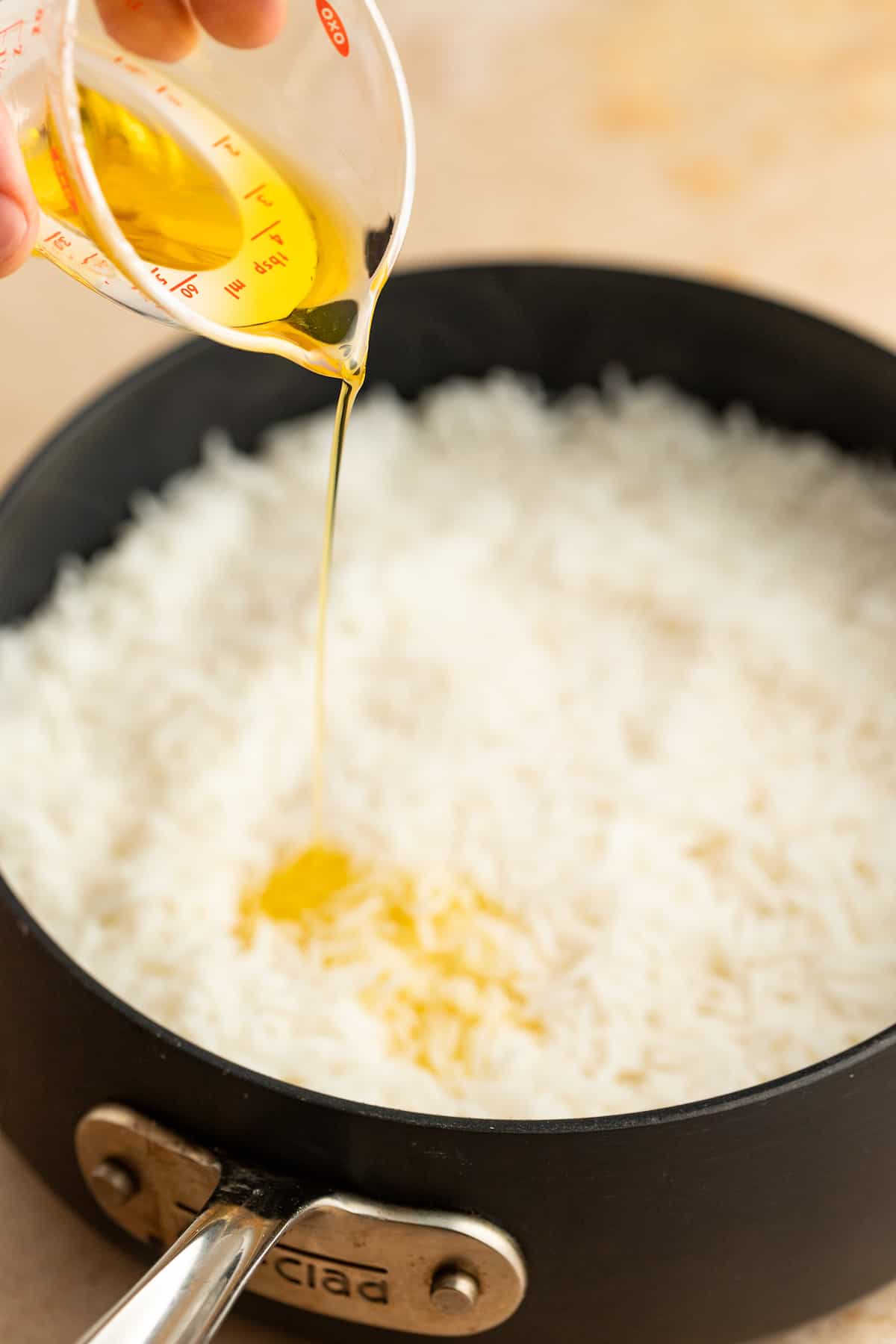
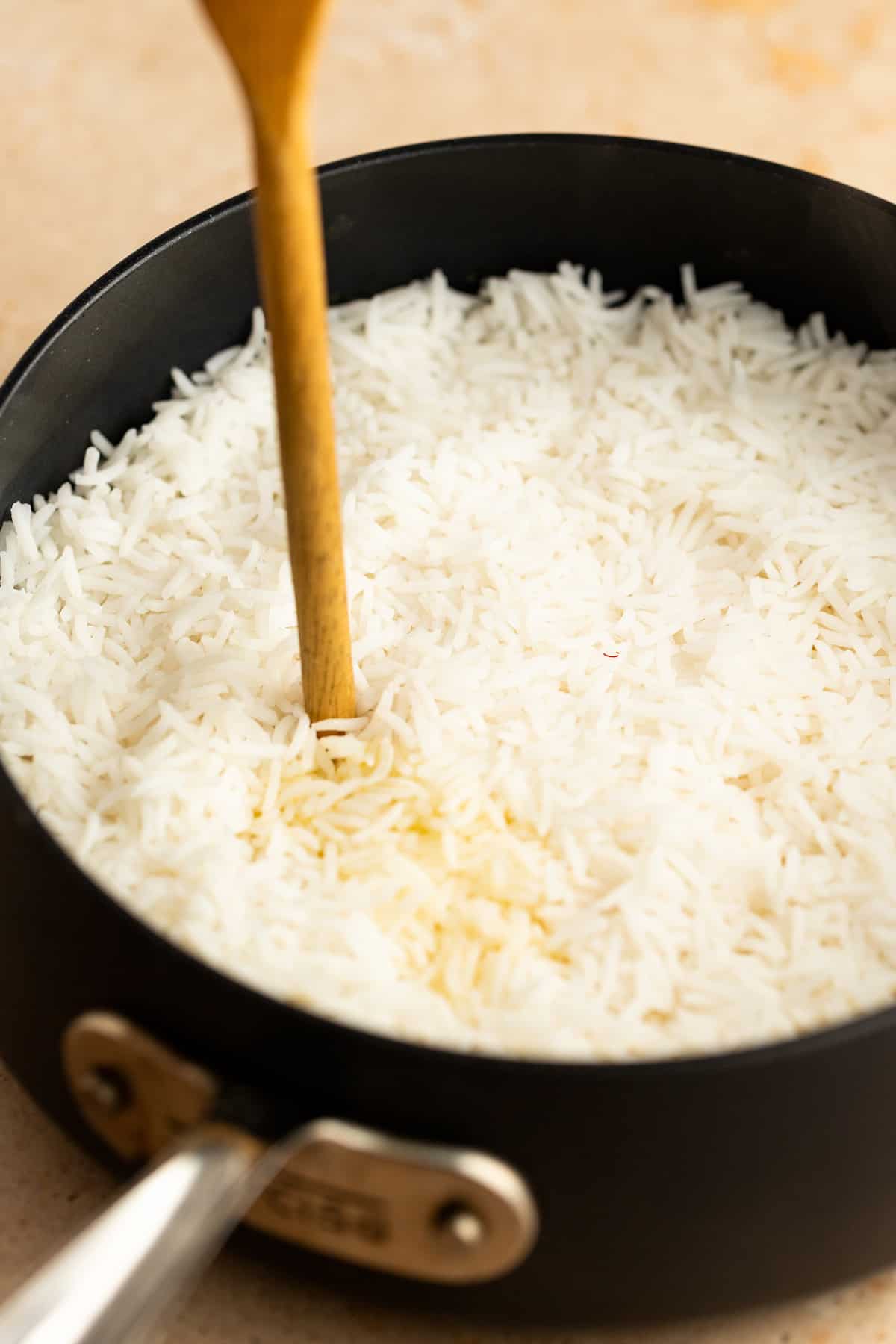
- Wrap the lid. Use a clean kitchen towel to wrap the pot’s lid. Tie it in place at the top (where the handle is). Reduce the heat to medium-low and cover the pot with the lid. Let the rice cook for 30 minutes or until the rice at the bottom is crispy.
- Unstick the rice. Remove it from the heat and remove the lid immediately. Let it rest for 5-10 minutes. Slide the wooden spoon along the edges of the rice to help loosen it. You can also squeeze a silicone spatula along the bottom to carefully lift it up any rice that may have stuck too.
- Flip it. Place a large, extended plate over the pot. Wear an oven mitt or place a dry kitchen towel in the hand that will handle the pot. While pressing the plate down with one hand, secure the pot with your other one. Carefully flip the pot and plate over. The tahdig should fall onto the plate.
- Serve. Set it on the table and remove the pot. Enjoy.

Tips for Successful Tahdig
These tips will help you avoid broken rice grains, burnt rice, and burnt hands.
- Don’t rub the rice. When rinsing the rice, don’t rub it together. Just stir it around the container to remove the excess starch. Rubbing it together will cause the rice to split during cooking.
- Use toppings. Add almonds, raisins, golden berries, and chopped cilantro as toppings to give your tahdig some personality and make it extra pretty.
- Use room-temperature ingredients. Use room-temperature ingredients to keep the cooking time unaffected by cold yogurt, eggs, ghee, etc.
- Avoid moist towels. Never use moist or wet kitchen towels when handling hot cookware. You won’t feel a thing for 2-3 seconds, but it’ll begin to burn badly after that. To avoid burns and kitchen accidents, always stick to dry kitchen towels.
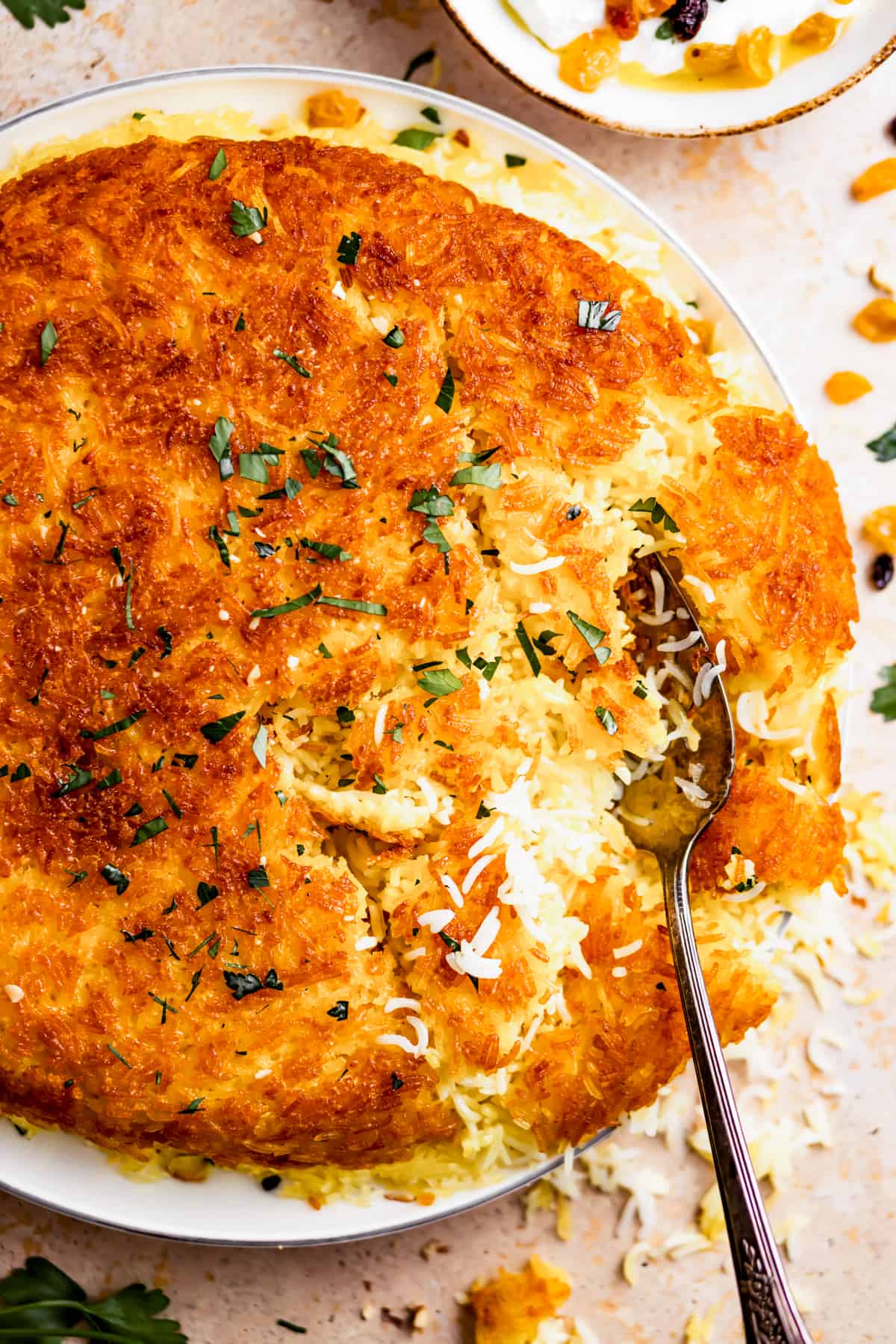
What To Serve With Persian Rice
Persian tahdig is amazing with other Middle Eastern and Mediterranean-inspired sides and main dishes. However, you can pair it with pretty much anything you like since it’s a simple rice recipe that doesn’t have too many spices.
- For veggie sides, try my Crispy Baked Falafel, Mediterranean White Bean Salad, and Grilled Vegetables with Halloumi.
- For protein-packed mains, I love my Marinated London Broil, Grilled Chimichurri Steak Skewers, Juicy Grilled Turkey Burgers, and Slow Roasted Lamb Shoulder.

More Easy Rice Dishes
- Easy One Pot Mushroom Rice Recipe
- Fiesta Rice Recipe
- Shrimp Fried Rice
- Lemon Rice Recipe
- Instant Pot Jasmine Rice
ENJOY!
Pin this now to find it later
Pin It
Tahdig (Crispy Persian Rice)
Ingredients
- 3 cups Basmati rice
- 3 tablespoons salt
- 15 saffron threads
- 1 tablespoon water
- ⅛ teaspoon ground turmeric
- 2 tablespoons unsweetened plain yogurt
- 1 egg yolk
- ½ cup vegetable oil
- ¼ cup ghee,, melted
Instructions
- Place the rice in a large container and fill it with water. Stir the rice around for 2 minutes. Strain the rice and repeat the process 2 to 3 more times or until the water is almost clear.
- Transfer the rinsed rice back to the container and add the salt. Cover it with warm water until the rice is submerged in 3" of water. Place a clean kitchen towel on top and let it rest for 4 hours.
- Fill a large pot with water and bring it to a boil over medium-high heat. Drain the rice. Add it to the pot and let it boil for 3 minutes. Strain the rice and rinse it. Set it aside.
- Grind the saffron threads to make a fine powder. Place it in a small bowl and add a tablespoon of cold water. Stir well and let it rest for 10 minutes. Stir again and let it rest for 5 more minutes.
- In a separate medium-sized bowl, whisk the yogurt, ground turmeric, saffron mixture, and yolk until well combined. Add a quarter of the rice and use a wooden spoon to gently fold it into the mixture. The rice should be evenly coated.
- Add the oil to a 4 or 5-quart saute pan set over medium heat. Add the yogurt-rice mixture and use a wooden spoon to spread it out evenly across the bottom of the pan. Let it cook for 5 minutes.
- Add the remaining rice on top and spread it out evenly. Drizzle the ghee over the rice. Use the back of a spoon to poke holes in the rice without reaching the bottom of the pot but getting as close to it as possible.
- Use a clean kitchen towel to wrap the pot's lid and tie it in place at the top (where the handle is). Reduce the heat to medium-low and cover the pot with the lid. Let the rice cook for 30 minutes or until the rice at the bottom is crispy.
- Remove the pot from the heat and remove the lid immediately. Let it rest for 5 to 10 minutes. Slide the wooden spoon along the edges of the rice to help loosen it.
- Place a large, extended plate over the pot. Wear an oven mitt or place a dry kitchen towel in the hand that will handle the pot. While pressing the plate down with one hand, secure the pot with your other hand. Carefully flip the pot and plate over. The tahdig should fall onto the plate.
- Set it on the table and remove the pot. Enjoy with your favorite sides and mains.
Notes
- Don’t scrub rice while rinsing; just stir to remove starch. Scrubbing can cause the rice to break during cooking.
- Enhance your tahdig with toppings like almonds, raisins, golden berries, and chopped cilantro.
- Ensure ingredients are at room temperature for consistent cooking time.
- Use only dry kitchen towels with hot cookware to prevent burns. Wet towels can lead to accidents.
- Towel-Wrapped-Lid: Covering the pot during the steaming stage with a towel-wrapped-lid is an ancient Persian cooking technique. Just be careful not to let the towel hang down the pot’s sides – it could result in a fire.
- Storing Leftovers: Transfer tahdig to an airtight container once fully cooled. Do it carefully so it’s as intact as possible. The crispy side should be facing upward in the container. Refrigerate it for up to 4 days.
- To reheat it, carefully flip the rice so the crispy side is on the bottom of a medium-sized pan. Heat it over medium-low heat for 6-12 minutes or until crispy again.
- Unfortunately, tahdig doesn’t freeze well; too many ice crystals and moisture find their way in and around the rice, making it impossible for the rice to maintain its texture.
Nutrition
Nutritional info is an estimate and provided as courtesy. Values may vary according to the ingredients and tools used. Please use your preferred nutritional calculator for more detailed info.









This is so tasty and delicious! My family really enjoyed it!
I love trying new dishes! I’ve never heard of this before, but definitely can’t wait to make it!
Love how crispy this rice is! I am so curious to make it at home!
Looks absolutely fantastic! Can’t wait to try this one!
This recipe looks very interesting. Love everything that goes into it. I need to try this very soon!
That is some fancy pants rice! It looks absolutely delicious and I can’t wait to make a big batch!